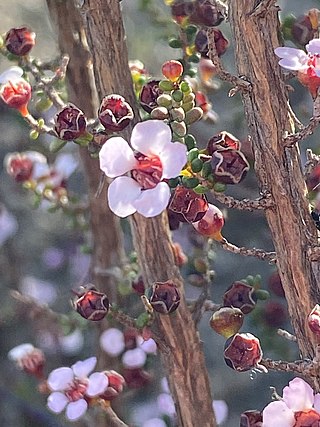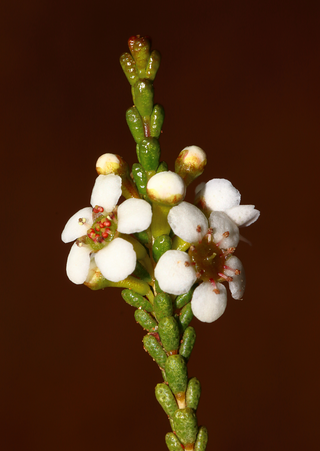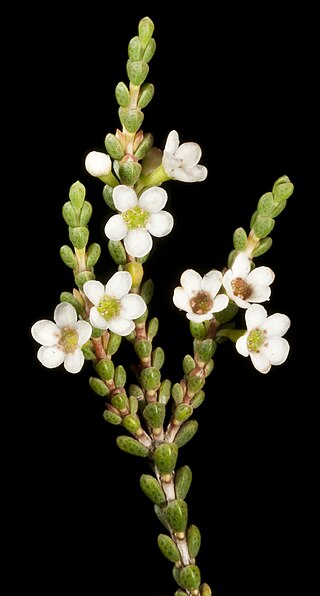
Rinzia orientalis, commonly known as desert heath-myrtle, is a species of flowering plant in the family Myrtaceae and is endemic to south-eastern Australia. It is a shrub with elliptic to narrowly oblong leaves and white or pale pink flowers usually with ten stamens.
Baeckea pygmaea is a species of flowering plant in the family Myrtaceae and is endemic to the south-west of Western Australia. It is a slender and erect or spreading shrub with narrowly egg-shaped to almost linear leaves and small white flowers with 12 to 25 stamens.
Micromyrtus acuta is a species of flowering plant in the myrtle family, Myrtaceae and is endemic to the southwest of Western Australia. It is an erect shrub with small, oblong leaves and small white flowers in the upper leaf axils.
Micromyrtus arenicola is a species of flowering plant in the myrtle family, Myrtaceae and is endemic to a small area in the southwest of Western Australia. It is an erect shrub with small, linear to narrowly egg-shaped leaves and small white flowers.
Micromyrtus chrysodema is a species of flowering plant in the myrtle family, Myrtaceae and is endemic to a small area of inland Western Australia. It is a densely branched shrub with small, narrowly oblong leaves and small white flowers.

Micromyrtus clavata is a species of flowering plant in the family Myrtaceae and is endemic to inland Western Australia. It is an erect, compact or sprawling shrub with erect, egg-shaped leaves with the narrower end towards the base and small white flowers arranged singly in upper leaf axils.
Micromyrtus collina is a species of flowering plant in the myrtle family, Myrtaceae and is endemic to a small area in the southwest of Western Australia. It is an erect shrub with small, linear to narrowly egg-shaped leaves and small white flowers that turn pink as they age.

Micromyrtus elobata is a species of flowering plant in the myrtle family, Myrtaceae and is endemic to the south of Western Australia. It is usually an erect shrub with small, narrowly to broadly egg-shaped leaves with the narrower end towards the base, and white flowers 3–5 mm (0.12–0.20 in) in diameter.

Micromyrtus erichsenii is a species of the family Myrtaceae and is endemic to Western Australia. It is an erect shrub with small, egg-shaped leaves with the narrower end towards the base, and white or cream-coloured flowers 3–4 mm (0.12–0.16 in) in diameter and 5 to 10 stamens.
Micromyrtus greeniana is a species of flowering plant in the myrtle family, Myrtaceae and is endemic to a small area in the west of Western Australia. It is a spindly shrub with linear to egg-shaped leaves and small white or cream-coloured flowers.
Micromyrtus hymenonema is a species of flowering plant in the myrtle family, Myrtaceae and is endemic to inland areas of Western Australia. It is a shrub with overlapping, decussate linear leaves and pink flowers arranged singly in leaf axils with about 10 stamens in each flower.
Micromyrtus imbricata is a species of the family Myrtaceae and is endemic to the south of Western Australia. It is a slender, erect shrub with broadly egg-shaped leaves, white, pink or red-tinged flowers 4–5 mm (0.16–0.20 in) in diameter, and 10 stamens.

Micromyrtus monotaxis species of the family Myrtaceae and is endemic to the Western Australia. It is an erect shrub with egg-shaped leaves with the narrower end toward the base, white flowers 4.5–6.0 mm (0.18–0.24 in) in diameter, and 10 stamens.
Micromyrtus mucronulata species of the family Myrtaceae and is endemic to the Western Australia. It is a shrub with linear to narrowly egg-shaped leaves with the narrower end toward the base, and white flowers 3.0–3.5 mm (0.12–0.14 in) in diameter.
Thryptomene dampieri is a species of flowering plant in the family Myrtaceae and is endemic to the north-west of Western Australia. It is a low, spreading shrub with prostrate stems, broadly egg-shaped leaves with the narrower end towards the base, and pinkish flowers with five petals and ten stamens.
Thryptomene naviculata is a species of flowering plant in the family Myrtaceae and is endemic to central areas of Western Australia. It is a rounded shrub with overlapping, decussate, egg-shaped leaves with the narrower end towards the base and white flowers with five petals and five stamens.
Thryptomene nitida is a species of flowering plant in the family Myrtaceae and is endemic to a small area in the south-west of Western Australia. It is a spreading shrub with upward-pointing, egg-shaped leaves with the narrower end towards the base, and flowers with five pale purple or pinkish petals and ten stamens.
Babingtonia maleyae, commonly known as the Narrogin babingtonia, is a species of flowering plant in the family Myrtaceae and is endemic to the southwest of Western Australia. It is a compact shrub with narrowly egg-shaped to elliptic leaves and white flowers usually arranged singly in leaf axils, each flower with 17 to 20 stamens.
Babingtonia minutifolia is a species of flowering plant in the family Myrtaceae and is endemic to a small area in the southwest of Western Australia. It is an erect, widely spreading shrub with narrowly egg-shaped to elliptic leaves and pale pink flowers arranged singly in leaf axils, each flower with 16 to 19 stamens in a circle.
Micromyrtus capricornia is a species of flowering plant in the myrtle family, Myrtaceae and is endemic to a small area of central eastern Queensland. It is a shrub with slightly drooping branchlets, overlapping, narrowly egg-shaped leaves and small white flowers.





